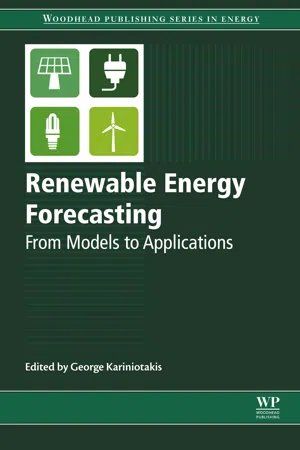
- 386 pages
- English
- ePUB (mobile friendly)
- Available on iOS & Android
About this book
Renewable Energy Forecasting: From Models to Applications provides an overview of the state-of-the-art of renewable energy forecasting technology and its applications. After an introduction to the principles of meteorology and renewable energy generation, groups of chapters address forecasting models, very short-term forecasting, forecasting of extremes, and longer term forecasting. The final part of the book focuses on important applications of forecasting for power system management and in energy markets.Due to shrinking fossil fuel reserves and concerns about climate change, renewable energy holds an increasing share of the energy mix. Solar, wind, wave, and hydro energy are dependent on highly variable weather conditions, so their increased penetration will lead to strong fluctuations in the power injected into the electricity grid, which needs to be managed. Reliable, high quality forecasts of renewable power generation are therefore essential for the smooth integration of large amounts of solar, wind, wave, and hydropower into the grid as well as for the profitability and effectiveness of such renewable energy projects.- Offers comprehensive coverage of wind, solar, wave, and hydropower forecasting in one convenient volume- Addresses a topic that is growing in importance, given the increasing penetration of renewable energy in many countries- Reviews state-of-the-science techniques for renewable energy forecasting- Contains chapters on operational applications
Frequently asked questions
- Essential is ideal for learners and professionals who enjoy exploring a wide range of subjects. Access the Essential Library with 800,000+ trusted titles and best-sellers across business, personal growth, and the humanities. Includes unlimited reading time and Standard Read Aloud voice.
- Complete: Perfect for advanced learners and researchers needing full, unrestricted access. Unlock 1.4M+ books across hundreds of subjects, including academic and specialized titles. The Complete Plan also includes advanced features like Premium Read Aloud and Research Assistant.
Please note we cannot support devices running on iOS 13 and Android 7 or earlier. Learn more about using the app.
Information
Principles of meteorology and numerical weather prediction
Abstract
Keywords
1.1. Introduction to meteorology for renewable energy forecasting
1.1.1. Atmospheric motion

Table of contents
- Cover image
- Title page
- Table of Contents
- Related titles
- Copyright
- List of contributors
- Part One. Introduction to meteorology and measurement technologies
- Part Two. Methods for renewable energy forecasting
- Part Three. Applications of forecasting to power system management and markets
- Index